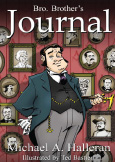By James T. Tresner II, Book Review Editor
So there I was, in a hotel in Atlanta, at the Conference of Grand Masters of Masons of North America. I’d been invited to present some break-out sessions, and I spotted my friend Bro. Cliff Porter at a table. He had also been invited to present some break-out sessions, and he had copies of his book, The Secret Psychology of Freemasonry, for sale. There was an extra chair at his table, which he offered, and I gratefully perched thereon.
At the same table was Brother Michael A. Halleran. I’ve written about his book The Better Angels of Our Nature: Freemasonry in the American Civil War, which is one of the best books on the topic I’ve ever read. But he also had copies of a new book, which I didn’t even know existed. Brother Halleran is probably best known to readers of The Scottish Rite Journal as the “discoverer” of a series of articles in the Journal. The new book, Bro. Brother’s Journal: The Early Years 1893–1911, collects those articles and adds some new ones. This is wickedly funny stuff! To an uncomfortable degree, I identify with Bro. Brother. He has an astonishing ability to miss the point. Ted Bastien’s illustrations capture the character perfectly. I think you will really like this book!
Halleran, Michael A. Bro. Brother’s Journal: The Early Years 1893–1911, Macoy Publishing, 2011, paperbound 152 pages, original illustrations, ISBN 978-0-88053-104-7, price $19.95 + S&H, order from www.macoy.com/bro-brothers-journal-by-Michael-Halleran-p6090.aspx
On the table next to the one at which Brothers Porter, Halleran, and I were sitting, was a display of some of the most beautiful and unusual Masonic aprons I’ve ever seen. They were the work of Brother Patrick Craddock, who owns The Craftsman’s Apron. He has some striking and unusual grand lodge aprons, but I was most impressed by the aprons for members. Some were historic recreations, but many were examples of aprons men had designed for themselves. Some were the traditional square shape, but others were the older “shield” shape. Some were embroidered, but many of the most beautiful were hand painted. Here is a chance to have an apron that reflects your unique Masonic vision. Brother Craddock works with people who want to design an apron until a final design is agreed on, and he then creates the apron as a real and original work of art. Let me suggest you visit his site at www.craftsmansapron.com Be sure to click on the custom aprons button to see some really fine designs.
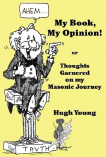 Young, Hugh, PGM, Grand Lodge of Alberta, My Book, My Opinion! or Thoughts Garnered on my Masonic Journey, Calgary, Alberta Canada: Linshaw Enterprises Inc. 2009, paperbound, 121 pages, ISBN 978-0-98117-808 price $19.95 + S&H, order from www.linshaw.ca.
Young, Hugh, PGM, Grand Lodge of Alberta, My Book, My Opinion! or Thoughts Garnered on my Masonic Journey, Calgary, Alberta Canada: Linshaw Enterprises Inc. 2009, paperbound, 121 pages, ISBN 978-0-98117-808 price $19.95 + S&H, order from www.linshaw.ca.
Copies of this book were being handed out at the Conference of Grand Masters, and I was lucky enough to snag one. It’s possible to suspect that MW Brother Young can be a little crusty when events warrant, but there is no doubting the wisdom with which he writes as well. Some of it hurts. Chapter 11, “When Masons Grow Old,” opens thus:
God, grant me the Senility
To forget the people I never liked anyway,
The good fortune to run into the ones I do,
And the eyesight to tell the difference.
For those of us who have fallen in the “sere and yellow Masonic leaf,” the chapter is a cautionary essay, to the younger ones it is an important explanation of what happens to a Mason as the years accumulate, and a blunt warning to let us totter along, lest we beset you with our canes. Curmudgeonry aside, there is good advice here for Masons, masters of Lodges, and the Craft in general. And, as he points out, if you don’t like it—tough! Fun and insightful read.
Now, as a special treat, some guest reviews.
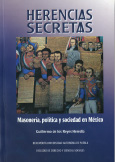 De los Reyes-Herdia, Guillermo. Herencias Secretas: masonería, política y sociedad en México (Secret Heritages: Masonry, Politics and Mexican Society). Puebla, México: Benemérita Universidad Autónoma de Puebla.
De los Reyes-Herdia, Guillermo. Herencias Secretas: masonería, política y sociedad en México (Secret Heritages: Masonry, Politics and Mexican Society). Puebla, México: Benemérita Universidad Autónoma de Puebla.
Dealing with Masonic matters in Latin American it is not easy due to its controversial nature and lack of availability of documentary resources. The controversial aspect has to deal with the strong Catholic enclave inherited by Spanish colonization, in particular for large countries like México, and the strong opposition by the Catholic Church to Freemasonry since the Papal Bull of Clement XII, “In eminenti” of April 28, 1738. The lack of primary documentary resources for adequate research is sometimes the most discouraging reason for researchers of Masonic subjects. Dr. de los Reyes-Heredia, a professor at the University of Houston, Texas, deals with both challenges in an outstanding manner, being able to present a book which is both adequate for the casual or curious reader and rigorous enough for the academic reader.
The book gives us a historical account of Mexican Freemasonry with a clear perspective on how Freemasonry was involved in the formation the Mexican nation. The book is well organized and logically divided in four sections. Part I, deals with the origins of Freemasonry, the Vatican’s involvement and its appearance in Mexico, exploring the role of the Craft in the independence of México from Spain. It shows how local Catholics sided with Freemasonry in the independence movement defying both the Spanish ruler and the Catholic Church.
Part II, is a logical continuation with a depiction of the political role, secularization, and anti-clericalism from 1820 to 1876. He describes the environment of censorship which forced the smuggling of Masonic books and the translation to Spanish of Thomas Smith Webb, The Freemason’s Monitor or Illustrations of Masonry in Two Parts which became the fundamental guide for the development of the York Rite in México. Dr. de los Reyes-Heredia explains the rivalry between the York (“Yorkinos”) and Scottish Rites followers, in particular the reasons for such contention among Masons.
Part III, takes us into the years of President Porfirio Díaz who was a Mason, the Mexican Revolution, and the involvement of Freemasonry in so many years of revolution. Part IV, continues beyond the revolutionary days and the transformation of Freemasonry in México. The book has an epilogue with a reflection about Freemasonry in its historical context and about Freemason’s leadership and their participation as active members of the political environment of the country. Finally, he closes the book with two appendix notes followed by a full bibliography.
The book is an excellent historical review of México and the involvement of Freemasonry in the creation of that country, both in positive and negative ways. The author depicts the participation of prominent masons from México, Spain, France, England, and United States in the formation of the México and its Masonic structure. The most important issue is how Dr. Guillermo de los Reyes-Herdia as a responsible researcher and a non-Mason, came to present how Freemasonry helped to spread the gospel of liberty and the formation of a strong society. This is a must-read book for anyone involved, in particular, with the Masonic or Mexican historical research or those countries involved in the development of Mexican nation.
—Book Review by Bro. Luis A. Otero-González, 32°, San Juan, Puerto Rico
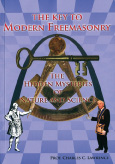 Lawrence, Charles C., The Key to Modern Freemasonry: The Hidden Mysteries of Nature and Science, Hamilton House Publishing, Ltd., 2011, 512 pages, 35 color plates, 30 monochrome plates, 16 tables, ISBN 978-0955039265, $29.99, order from www.lewismasonic.com.
Lawrence, Charles C., The Key to Modern Freemasonry: The Hidden Mysteries of Nature and Science, Hamilton House Publishing, Ltd., 2011, 512 pages, 35 color plates, 30 monochrome plates, 16 tables, ISBN 978-0955039265, $29.99, order from www.lewismasonic.com.
Bro. Charles Lawrence, Emeritus Professor of Engineering at the University of East London, brings a unique approach to Masonic research: the scientific method. His particular interest is in discovering who was responsible for inserting scientific concepts (some outmoded today) into Masonic ritual. He approaches the problem with the cold logic of Francis Bacon and the dogged determination of a bulldog. Following his reasoning is like watching a murder mystery as the detectives determine who had means, motive, and opportunity.
In the course of his investigation Bro. Charles looks into the mathematics of the dome of St. Paul’s Cathedral in London, the changing understanding of the nature of light, the noble families connected with Freemasonry, and the founding fathers of the fraternity. He casts a figurative net around each suspect, and the overlapping nets become circles in a Venn diagram to narrow down the suspects.
I’m not sure which I enjoyed most: the side trips into 18th-century science, the biographies of the possible authors of the inserted scientific passages, or the overview of English history interwoven with that of Freemasonry. The book assumes its readers are familiar with the English Royal Arch, which is a bit different from what we use in the US. I thought that Bro. Lawrence assumed too early a date for the appearance of some of the Royal Arch lectures without sufficient evidence, but his scientific approach to narrowing down suspects is a marvel to behold.
—Book review by Ill. S. Brent Morris, 33°, G.C., Baltimore, MD, and Washington, D.C.
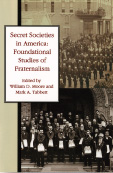 Moore, William D and Mark A. Tabbert, Secret Societies in America, Foundational Studies of Fraternalism, Cornerstone Book Publishers, 2012, paperbound, 296 pages, ISBN 978-1-61342-024-9, price $24.95 + S&H, order from cornerstonepublishers.com.
Moore, William D and Mark A. Tabbert, Secret Societies in America, Foundational Studies of Fraternalism, Cornerstone Book Publishers, 2012, paperbound, 296 pages, ISBN 978-1-61342-024-9, price $24.95 + S&H, order from cornerstonepublishers.com.
Anyone fascinated by fraternal organizations or “secret societies” knows that something happened 100 to 150 years ago. That something was the birth of an amazing profusion of new organizations, each fine-tuned to meet some need of its members: health, life, or burial insurance, a place to drink, a place to be with others like them, or moral uplift. And each of these brave new societies patterned itself after Freemasonry with passwords, handshakes, hierarchical memberships, and distinctive regalia. From this high watermark of fraternalism over a century ago we have with us today the Shriners, the Grotto, the Elks, the Moose, the Eagles, the Knights of Columbus, and more. The modern structure of the Family of Freemasonry evolved during this period: Blue Lodge, Eastern Star, Scottish Rite, York Rite, and Shrine.
Bro. Mark Tabbert and Prof. William Moore are two leading students of this period and movement. They have gathered together nineteen original articles that describe the fraternal movement first hand, from the perspective of someone who lived in the period. These essays provide a fundamental understanding of how “secret societies” were viewed at the time. It’s virtually impossible to find membership figures for many of these groups, but W. S. Harwood gives contemporary estimates in his 1897 article in the North American Review. And while fraternal benefit societies were the foundation of our modern insurance industry, they didn’t always live up to their goals, as Walter H. Page points out in his 1911 article from The World’s Work. On top of the reprints of original works, Prof. Moore has a wonderful (if too short) overview of the period and the movement.
If you like fraternalism, if you want to understand the immediate roots of 21st-century Freemasonry, if you like exploring obscure byways of American history, then this is a must-have volume for your library. Buy it now!
—Book review by Ill. S. Brent Morris, 33°, G.C., Baltimore, MD, and Washington, D.C.






